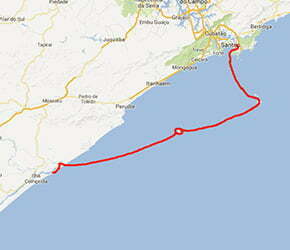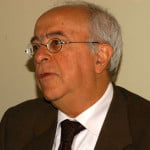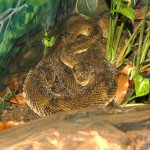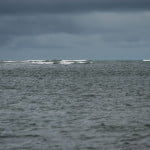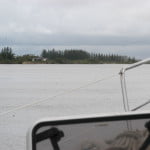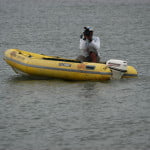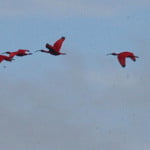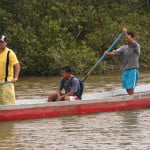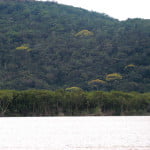Sunday – 15 – 10 – 2006.
The sailboat left Santos in the early morning. The Endless Sea was getting used to its home, Pier 26; but we had to leave again. In spite of having recorded programs in advance, time goes by regardless of good or bad weather. Most of the stored programs have already been shown. It is time to sail again.
This time we are going to shoot all this content for one single program. I think it is a pity to show such interesting material in only 24 minutes; but this is the rule. I have to continue. And the series must have an end, no matter how much I like it. Our deal was to cover the Brazilian coast in 90 episodes. And this will be done.
Alonso, Paulina and film maker Cardoso are on board this time. I had made an appointment with a possible future sponsor on Tuesday 17. However, our departure couldn’t be delayed any longer; there wasn’t almost any unseen episode left.
So the crew had to leave before me and shoot the islands on the first days. I would join them on Tuesday, in Iguape.
From this trip on there are two new things. In addition to Semp Toshiba, we have a new sponsor: Sagatiba. Until the end of the series, I hope we can count on this significant additional support. We can also count on a meteorologist’s help.
We are now at a latitude that is dangerous and as we go southwards it gets worse. Here the cold fronts are quite strong and very often there isn’t any shelter in the sea in an area over a hundred miles.
That’s why I asked a good friend of mine to help us, Joselia Pegorim, from Climatempo, a company we found and hired for the weather forecast on Radio Eldorado, who she has been in charge of it since the eighties.
She is very competent and a nice person. She has already done this type of work for the Eldorado-Brasilis regatta’ flotilla, Refeno’s and many others.
She will be working for us on this trip and the others, but from São Paulo, not with us on board. She will monitor the weather and inform us. The weather forecast she gave us decided the sailboat’s departure date. She warned us yesterday that a cold front would arrive in Iguape on Monday evening. “The (cold air) mass is a bit strong” she said. Since that bar is quite dangerous, relatively low, it is wise to avoid entering with the south wind. The waves are bigger. So the best thing to do is to arrive before the mass.
That’s why I sent the crew before. They left Guaruja and sailed to Laje de Santos and then to Queimada Grande Island, where they are going to sleep tonight. Tomorrow morning they will go to Iguape early.
I called a friend, professor Antonio Carlos Diegues, who lives there. I told him the arrival date and time and asked him to find a local pilot to help Alonso.
In a few minutes everything was arranged. Diegues gave me Mingo’s telephone number, Iguape’s remarkable character, who I have just spoken to. Tomorrow he is going to go to the bar in Icapara to find a fisherman to guide the Endless Sea in the entrance.
Monday, 16 – 10 – 2006.
Mingo called me before 8 a.m. He had already spoken to Amarildo who lives at Icapara end and will guide Alonso.
I have already called everybody’s cell phones on board to give his name and phone number. Amarildo will wait for them. Now I have to concentrate on tomorrow’s meeting and hope it will be all right.
Tuesday, 17 – 10 – 2006.
It was an excellent meeting. If I’m not wrong I sold another quota. I will know if I succeeded after this trip. As soon as I finished the project show, I left. I got on board this afternoon at 4. I was going towards the river and looking for the pier amazed at the beauty of the city’s historical center, when I heard a loud whistle. That sound was familiar. I stopped and looked back. Cardozo was going out of a hut.
When I got out of the car, he introduced me to Mingo, who I had already spoken to many times. He was the owner of that garage. Cardozo and Paulina were there looking for the clutch driver knob of the motor of the Endless Sea. It was funny and unexpected to meet the three of them at once. It was raining and a little bit cold.
Paulina and Cardozo were speedy due to the excitement felt in the entrance of the bar. They mentioned many times the size of the waves. They broke on both sides of the boat as the Endless Sea surfed down on them. They also said that when they were entering, Alonso was at the rudder visibly excited explaining to Cardozo’s camera the maneuver. He said that “it had been the worst bar since the beginning of the trip”. I froze, but they assured me that the pilot was a real expert and knew the entrance perfectly and calmed me down.
As soon as I got on board I asked to see the recording. Jesus Christ! What excitement! There was a very high level of adrenaline on board. It was not even necessary to tell me. The recording showed clearly on their faces what they were feeling as the boat “flew” sliding on the waves of the bar.
In the entrance canal, the waves made the Endless Sea speed up as a surfboard going down. We can see it clearly. However, unlike the surfboard which is light with a flat hull, the sailboat has a keel and is very heavy. It is difficult to control it at high speed. Just the fact of watching the recording made my heart beat faster. If I had been on board, I don’t know if I would have been brave enough and permitted the entrance.
Many obstruction and erosion problems at Iguape’s bar were caused by man who in 1852 opened Valo Grande, the famous artificial canal. The idea was to make cargo transportation easy, especially the transportation of the gold extracted as well as the production of the Ribeira valley to Mar Pequeno and then to Iguape port.
At the beginning, the canal was about 4 meters wide but after it was opened, the strength of the waters of Ribeira started to erode and “push” the banks back. After 150 years, the canal is about 300 meters wide. Part of Iguape city collapsed. The old cemetery, streets, houses, everything was swallowed by the strength of the water. There is worse: the sediments brought obstructed the port completely. But this wasn’t the main problem. The excess of fresh water canalized towards the estuary system, the amount and the variety of fishes decreased drastically. This rich activity vanished when Valo Grande was opened and changed the bar completely. Local inhabitants were astonished when they saw the Endless Sea enter. It’s been a long time since they last saw such a big boat in the area.
After that disaster, it took local inhabitants almost a hundred years to close the canal. This only occurred when a barrage was built in 1978. But, their happiness didn’t last long. In 1983, the full waters of Ribeira de Iguape, the biggest and most important hydrographic bay along approximately 400 kilometers of Sao Paulo’s coast, devastated Valo Grande’s closing works and the river started to flow into Mar Pequeno again.
Ribeira de Iguape’s waters also bring a huge amount of pesticides used in agriculture as well as residues released by the great amount of mining extraction (lead, manganese and zinc) from the valley through which the river bed flows. The fresh water decreases the salt content of the whole area which is about 90 miles long, from Iguape to Paranagua, in the state of Parana. Shrimps and oysters are the most affected crustaceans, but not only them. The bay Iguape-Cananeia-Paranagua is considered the biggest fish breeding place of Brazil’s south and southeast coast.
This could be used as an example and maybe avoid other changes caused by works made on the Brazilian coast.
Unfortunately, there is bad weather. I knew it would be like this. We can’t wait; we will have to shoot with this weather.
Last night, Paulina told me that they had been able to work more profitably when the weather was not that bad. Several interviews had already been made and most of the city’s beautiful colonial settlement had been recorded. Nevertheless, we have lots of things to do tomorrow.
Wednesday, 18 – 10 – 2006.
This morning we had a meeting with Dauro Marcos do Prado, a fisherman from Jureia beach. Since 1987, this area has been an Ecological Station, a full protection unit. In Brazil, parks and similar units don’t accept inhabitants or their action is extremely refrained. This is a controversial issue which has to be examined. As far as I’m concerned, I’m not convinced it has necessarily to be like this. I’ve read about it and I’m going to ask environmentalists and the academic community, who I’ll talk to and interview, what they think about this issue.
Dauro’s situation, for instance, is emblematic. His version as well as the issues on what happened in Jureia after 1986’s state decree, which determined it was a Conservation Unit, must be clarified.
When we asked him about the origin of his family, he said that his great grandfather was born, had children and died, in that place. He always made his living from extraction and subsistence farming. From time to time, he would go to the bushes and cut a tree to make a canoe. He depended especially on it to survive.
He weeded a small area for plantation. However, he subsisted basically on fishing and once in a while on hunting.
His grandfather and his father lived the same way. And then, it was his turn.
After a quarrel between the Army who wanted to build a Nuclear Plant and real estate speculation; environmentalists won the battle. This is how Jureia became a Conservation Unit. The area has 80 thousand hectares of Atlantic Forest and it includes part of Iguape, Peruibe, Itariri and Miracatu districts. It was a victory. However, not without consequences.
According to the new order, 90% of the area should be preserved; 10% could be explored for scientific purposes.
In a very short time, Dauro and about 350 families were not allowed to keep their traditions and habits. Like in a sleight of hand, the victim became the villain. This is more or less the situation of our friend.
He says that, at that time, nobody explained anything to the inhabitants of those 22 surrounding communities. “They just said that the decree would stop real estate speculation.” He adds: “And then everything was forbidden: plantation, fishing, extraction. Everything was over at once.”
Obviously, people objected. A few people from all the communities complained and tried to organize the others; they were the leaders. Well, according to Dauro, these leaders were hired by the government as park wardens. These opponents became protectors; and what is worse, the station inspectors.
According to Dauro, they were invested with this authority when they were given the uniform, boots and the gun. They started to inspect, especially the members of their own community or family. Chaos reigned.
Dauro told us about the problems he had with a cousin who had become a park warden, or his father who followed the same way. He told us many situations when the wardens knew there would be hunting for dinner and applied the rule of crime detected in the act in his own family.
In addition to all the prohibitions which local inhabitants were submitted to, there was this outrageous rule which turned some of them into wardens and disagreement reigned in most of the communities. It is unbelievable! Imagine someone inspecting his own brother and all the problems this may bring.
The result couldn’t be different. Approximately 60 families left the area and went to Iguape’s surrounding neighborhoods and to other cities in the area. Later, according to Dauro, “some of them died in confrontations against the police or were arrested because of drugs.”
Of course. Unable to live the traditional way, fishermen were attracted by the illusion of “easy life” and collapsed in the world of drugs and prostitution.
Many of them couldn’t stand the situation and in 1989 founded the Union of Jureia’s Inhabitants. They started to struggle for what they thought were their rights and one of them was to have areas where they could develop their way of life.
In 1992, after building was forbidden in Jureia, Dauro came to Iguape and joined the movement.
More recently, they have been supported by two congressmen who proposed a bill to turn two areas, one in the interior, Despraiado, and the other on the coast, Barra do Una, into RDS – Reserve of Sustainable Development. In these areas, they would be free to have their traditional way of life and explore ecotourism. According to Dauro, this bill will be voted before the end of the year.
What this fisherman told us about the changes that this area and the traditional inhabitants have gone through shows how the environmental policy has been applied in Brazil. One of the problems is very often the hardship faced by the weakest part. They end by paying a very high price and very often they barely get anything back. To me this is at least a questionable policy.
I remember that since we started this documentary, we have seen dozens of traditional craftsmen, especially shipyard carpenters who have remarkable backgrounds and cannot work and use it. Meanwhile, as Dauro says, “the government is very strict and doesn’t inspect” and the real criminals, those who cause great damage – very often definite damage – remain unpunished. Deforestation in the Amazon continues. Mangrove areas are in the hands of crustacean breeders, for free, to be destroyed. Resorts devastate the Northeast’s most beautiful landscapes, supported by fiscal renunciation of several state governments. Smuggling wild animals is a common practice. And palmetto trees cutters keep on cutting Palmeiras Juçaras , including here in Jureia, without being disturbed. In all these cases, the government’s official policy is ineffective. Why is inspection cruel only in regard to poor fishermen or traditional populations? This is something we must think about…
Before ending this issue, I would like to remind you that Jureia was almost given to the Army as the base of a nuclear plant. And then it was free from condominiums when they made Gomes de Almeida Fernandes, which intended to build a giant here, give it up. At last, it became a protected area; however, the social cost was very high.
Before the end of our conversation, I came up with a test and asked Dauro when he had last seen a forest guard arresting a palmetto cutter or an illegal land plotter. He searched in his mind. There was silence for a couple of seconds. And then he looked in my eyes and moved his head from right to left.
We went downtown to have lunch. And then I took pictures of Iguape’s historical center, fruit of the wealthy period of gold extraction and then the rice culture.
Before going back to the Endless Sea, we visited one of Iguape’s last salting place in order to record this old and traditional technique to benefit the fish.
It is in Rocio neighborhood and the owner is Sr. Nishidate, a Japanese man, of course. In the storage shed, there was something like a cemetery of trunk canoes which were part of his old fleet now renewed in glass fiber.
I bought a beautiful canoe and this time having the natural size. I’ll send it by truck to São Paulo.
That’s all for today.
Thursday, 19 – 10 – 2006.
This morning we went with Dauro to watch a Fandango’s special show which is very live here and on Parana’s coast. We went to Barra do Ribeira’s village at Jureia’s border, where the group performs. We have also been at the workshop where one of the participants makes his own fiddle, the main soloist among the string instruments used.
We asked about the origin of the fandango, but the current performers didn’t know how to answer. They forgot the Portuguese origin influenced by Spain which is significant in this area due to the presence, not far from there, of people from the Azores who settled especially on Brazil’s south coast. Anyway, they played and danced.
To reach the village, we had to cross Ribeira de Iguape by barge. I saw one of the most beautiful fishing canoes: Vanda (see pictures). I was on land which enabled me to take lots of pictures and observe the design carefully. In spite of knowing this area very well, because of past trips; I didn’t remember the shape of the canoes. Unlike most of the other canoes we have seen on the Brazilian coast, here they have an elongated prow and the stern is straight. Only the São Francisco River’s canoes are like these. They are beautiful. We shot them and took pictures.
Since we had a precious recording material, I decided to make two programs instead of one. We haven’t even reached Jureia’s Station; we already have so many images and different issues that it would have been impossible to edit it in one single episode.
In addition to the beauty of the canoes and their unique “shape”, the other thing that was impressive to me in Iguape, especially Comprida Island (it is 74 kilometers long and 4 meters wide) which is one more Environmental Protection Area, an APA; is the huge amount of pinus. It is unbelievable. In certain areas such as the reef of the island the amount is the same as the native trees’.
Since the state of Ceara we have insisted on how absurd it is to plant pinus on the coast where there are so many beautiful native trees. If in the Northeast there are a few, here we can see lots of them.
The worst is the fact that I’m the only one who sees them. Even the crew members are not as disgusted as I am when we see them. Sometimes, I am the only person who feels disgusted about them. Even environmentalists seem to accept it and don’t bother, in spite of knowing that the bioinvasion issue is seen as the second worst problems in terms of ecological damage, just leaving behind the devastation of natural habitats.
This problem is similar to that of animals introduced on the islands. Why not killing them before they exterminate the local diversity where they were brought to?
See what happened on Anchieta Island on the north coast of São Paulo. Zoologico Foundation introduced capybaras, cotias and sagoins. They are a calamity today. They proliferated, there are hundreds of them and the park authorities (Anchieta Island is a state park) say that “now they will meet and examine the situation and see what shall be done”. They waited 20 years to “examine” the situation. Is it possible?
If I had not seen it and heard about it, I wouldn’t have believed. In Abrolhos, it is the same with the goats introduced by the Portuguese devastating all the remaining vegetation. Nevertheless, they keep on devastating it. When I asked the park warden, on this trip, the young man didn’t seem to care about it. It didn’t have anything to do with him.
When I see pinus growing freely on the coast, and the god-damned goats eating uninterruptedly, I remember the famous environmentalist who attacks whaling ships. On these occasions, I say to my mates that next trip I will bring motor-saws and rifles…
After lunch we had something interesting to do. We recorded and took pictures of the last canoeist who still uses a sail as propulsion in Iguape. The precious clue was given again by professor Diegues.
Seu Apparicio, yes with double p, was very nice and didn’t mind putting the mast in his canoe, Panther, painted in red, with the prow and the stern slightly round like most of the canoes of the Brazilian coast. Seu Apparicio sailed up and down through Valo Grande canal, while we recorded it.
It is amazing how easy it is to handle these canoes. The mast is light and the sail is trapezoidal, very simple, designed by him and sewed by his wife. To control the sail, he uses only one sheet tied to the end of the boom. With one of the hands he holds this cable and with the other, the oar, which is the rudder. Everything is very simple without the uncountable number of cables and stays (steel cables which hold the mast) used in most modern sailboats.
We returned to the Endless Sea anchored a few meters before the bridge which connects Iguape to Ilha Comprida. It was the end of one more day. Before going to bed, we still had to solve some problems. Iguape’s fishermen spend a significant part of the day releasing huge nets in the canal to fish manjubas. Since the current is very strong, often one of them curls up the Endless Sea’s anchor chain and wraps the entire boat. That’s what happened yesterday and today again. But it’s not really tough to release it.
Right now Paulina is working on the tapes we recorded today; I am writing at the plotting table. Alonso went to bed a long time ago and Cardozo is outside enjoying the night.
We will continue tomorrow.
Friday, 20 – 10 – 2006.
We left early in the morning to see the nest area of flamingoes as well as other birds on the reef of Comprida Island. One more time, the large amount of pinus on our way caught my attention. This type of tree has already reached the banks and has started to replace the mangrove.
Comprida Island is already covered by buildings. The real estate speculation started here at the end of the seventies and it increased after the bridge, which connects Iguape to the island, was built. Condominiums and summer houses were built in reef areas or on small dunes. On vacation, the population triples and basic sanitation is far from being effective, as usual. These aspects are constant sources of pressure which act together in the worst area.
Comprida Island is of the utmost importance in the ecosystem. The island separates the sea from the lagoon area and it allows the formation of the mangrove area. The mangrove leaves fall on the mud and form an organic mass which is the base of the food chain for fishes and crustaceans. Since they are being replaced little by little by “invader” trees, or filled with earth to have marinas and houses instead; the estuary is damaged in regard to its main role, which is the natural breeder of maritime life. Tourism is Comprida Island’s greatest source of revenue.
It was pouring when we arrived at the flamingoes’ nest area. We had to shoot and take pictures under the umbrella. It was pretty tough. Just imagine holding an umbrella with one hand, and with the other, a heavy camera with a big zoom lens! Well, that’s what I had to do.
The flamingoes found here are those which live in the mangroves of Santos and Cubatão. And there are plenty of them, at least in Iguape. I was happy to see them again. There were too many in the past. Now they are back. This is one more proof of the strength of nature’s regeneration. If we give a little help, the rest is spontaneously done by nature itself.
It has been the same with the turtles after a couple of years of serious work by Tamar’s team. Today it is possible to find them almost all along the Brazilian coast. This encourages me and proves that if we change our habits a little bit, if we consume with more precaution, and if we dirty our planet a little bit less, there is time to save most ecosystems.
After recording, we returned to Iguape to have lunch. And then we went by car to Jureia. There are no sheltered bays where we could leave the Endless Sea. Our sailboat will stay here, Alonso will be in charge of it, and we will go by car to Peruibe.
When we arrived at the city, I was badly impressed. There are huge buildings all along Peruibe’s coast; pinus cover all the streets and avenues. This means they were planted by the city administration.
A few environmentalists who we met in Iguape told us the same thing. In the eighties, the city administration itself distributed the cuttings to those who wanted to plant them. Probably, this reflects old IBDF’ reforestation policy; an issue I mentioned in the last logbook. It’s pitiful.
It was late when we arrived. There was just time left to go the headquarters of Jureia-Itatins Ecological Station to arrange our walk for tomorrow. It was getting dark when we left.
We went to a hotel hoping the weather forecast given by our friend Josélia would be correct. She says we will have a sunny day tomorrow. I hope so. The beauty of the Ecological Station must be recorded with good weather.
Saturday, 21 – 10 – 2006.
Early in the morning we went again to the headquarters of the Ecological Station. The head of the inspection was waiting for us to guide us during the visit.
We left in a 4 x 4 van and visited part of the protected area.
We went to Una beach where a few fishermen still keep their traditions. Mostly there are summer houses whose owners bought the property and built them discretely rather in the back. In spite of the large number of people who visit it every year, about 50 thousand, the landscape is still exuberant and almost unchanged.
Una beach is very big with hard sand and long. The waves break along the whole beach and the dark waters contrast beautifully with the light color of the sand.
From Una Beach we went to two other beaches: Carambore and Desert Beach. On the way, we stopped to shoot Toucans with exuberant forest and the Una River which crosses it. We also saw the wonderful Tie-Sangue as well as other birds.
All the area is very beautiful. The colors of the forest and the different shades covered by the sun, bringing nuances in the colors; all this is astonishing.
Since the sun followed us almost all day long; according to our friend’s weather forecast, we recorded a wonderful program.
At the end of the day, we left to São Paulo.
Next time we will leave Sao Paulo through Cananeia and will arrive in the 14th state, the third before the last state of our journey: we are going to visit Parana’s coast.
See you.


